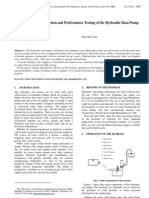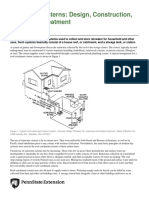0 ratings0% found this document useful (0 votes)
99 viewsRam Pump PDF
Ram Pump PDF
Uploaded by
oliververonamanuelHydraulic ram pumps provide a way to transport water from streams or creeks to livestock troughs without electricity by using the kinetic energy of flowing water. They work by using the force of flowing water down a drive pipe to power a pump that moves a smaller amount of water to a higher elevation. The document discusses the history of ram pumps, how they work, considerations for installing a ram pump system including minimum stream flow and elevation requirements, components of a ram pump system, and guidelines for designing and installing a site-specific system.
Copyright:
© All Rights Reserved
Available Formats
Download as PDF, TXT or read online from Scribd
Ram Pump PDF
Ram Pump PDF
Uploaded by
oliververonamanuel0 ratings0% found this document useful (0 votes)
99 views9 pagesHydraulic ram pumps provide a way to transport water from streams or creeks to livestock troughs without electricity by using the kinetic energy of flowing water. They work by using the force of flowing water down a drive pipe to power a pump that moves a smaller amount of water to a higher elevation. The document discusses the history of ram pumps, how they work, considerations for installing a ram pump system including minimum stream flow and elevation requirements, components of a ram pump system, and guidelines for designing and installing a site-specific system.
Original Title
ram pump.pdf
Copyright
© © All Rights Reserved
Available Formats
PDF, TXT or read online from Scribd
Share this document
Did you find this document useful?
Is this content inappropriate?
Hydraulic ram pumps provide a way to transport water from streams or creeks to livestock troughs without electricity by using the kinetic energy of flowing water. They work by using the force of flowing water down a drive pipe to power a pump that moves a smaller amount of water to a higher elevation. The document discusses the history of ram pumps, how they work, considerations for installing a ram pump system including minimum stream flow and elevation requirements, components of a ram pump system, and guidelines for designing and installing a site-specific system.
Copyright:
© All Rights Reserved
Available Formats
Download as PDF, TXT or read online from Scribd
Download as pdf or txt
0 ratings0% found this document useful (0 votes)
99 views9 pagesRam Pump PDF
Ram Pump PDF
Uploaded by
oliververonamanuelHydraulic ram pumps provide a way to transport water from streams or creeks to livestock troughs without electricity by using the kinetic energy of flowing water. They work by using the force of flowing water down a drive pipe to power a pump that moves a smaller amount of water to a higher elevation. The document discusses the history of ram pumps, how they work, considerations for installing a ram pump system including minimum stream flow and elevation requirements, components of a ram pump system, and guidelines for designing and installing a site-specific system.
Copyright:
© All Rights Reserved
Available Formats
Download as PDF, TXT or read online from Scribd
Download as pdf or txt
You are on page 1of 9
At a glance
Powered by AI
Hydraulic ram pumps can provide livestock water away from surface water sources while improving animal performance and limiting environmental concerns. They work using stream flow and do not require electricity.
Hydraulic ram pump technology has been used since the late 1700s in England and France. Interest grew in the 1800s and declined in the US in the 1890s as electricity became more available, but they are still used worldwide today.
Ram pumps use a large amount of water falling a short distance to pump a smaller amount to a higher elevation, with only 2-20% of the inlet water pumped to the outlet. They work by using the force of flowing water to open and close valves to pump water uphill.
TECHNICAL NOTES
U.S. DEPARTMENT OF AGRICULTURE NATURAL RESOURCES CONSERVATION SERVICE
PORTLAND, OREGON SEPTEMBER 2007
RANGE TECHNICAL NOTE NO. 26
Hydraulic Ram Pumps
Livestock watering systems are used to aid in getting better animal distribution within a
range unit or pasture. Many of these systems use springs and gravity or wells and
pumps to get water into troughs. Creeks and streams and ponds are often used where
they are located to provide water on site. Research has shown that livestock perform
better with water provided in a clean trough than when drinking directly from existing
surface water sources. There is increasing pressure to limit the use of surface water
sources for livestock use. Hydraulic ram pumps can be used to provide water away
from the flowing stream or creek, while improving animal performance and limiting
environmental concerns. Hydraulic ram pumps are well adapted to locations where
other power sources are limited. They do not need any electricity, can work anytime the
stream is flowing, and do not need wind or sunshine to operate.
This technology note is designed to provide the history of ram pumps, describe how
they work, and be a general guide to applicability. Site specific designs need to be
completed under the supervision of a licensed engineer. This technology note does not
provide enough specific information to complete such a design but does indicate the
types of information needed to complete the site specific design.
History
Hydraulic Ram Pump technology has been around since the late 1700s. The first
record is found in England in 1772 for a precursor to the ram pumps of today. This
earlier pump was called a pulsation engine and was designed by Edward Mangino of
Cheshire, England.
The first record of an actual ram pump is from France in 1796. J oseph Montgolfier
added some valves and thus automated the earlier pulsation engine. This pump was
patented in England in 1797 and improved in 1816.
The first United States patent for ram pumps was issued in 1809 to J . Cerneau and S.S.
Hallet.
Interest in ram pumps continued throughout most of the 19
th
century as more patents
were issued in the United States and the French design and British patent were
acquired by J osiah Easton of London, England.
In the United States, interest in ram pumps declined in the 1890s as electricity and
electric pumps became more widely available.
Today, ram pumps are installed and functioning worldwide.
General Functioning Principles
The basic principle behind ram pumps is to use a large amount of water falling a short
distance to pump a small amount of water to a higher elevation. Typically, only 2% to
20% of the water flowing through a ram pump system will actually be delivered to the
storage tank or trough. The remainder is overflow and directed back into the stream.
Limitations
o Plastic pumps are limited to very low delivery heads
o Output head (approx. equivalent to height) is usually 5-25 times the input
head (approx. equivalent to fall)
o Pump efficiency
Usually 50% to 60%
May be as high as 80%
May be less than 40%
The amount of water delivered to the end use will depend on
Source flow
Height of supply reservoir above pump
Height of delivery site above pump
Length and size of delivery pipe and drive line
Pump efficiency
Size of pump
Given all these variables, the amount of water delivered with a single 2 ram pump
system can range from a low of 17 gallons per day to 4,000 gallons per day or more.
Can you use a ram pump in your situation? Here are some minimum guidelines to help
answer that question.
Site Characteristics Recommended Minimums
Stream Flow 8 gallons per minute (0.018 cfs)
Stream Gradient 2 percent (2 feet fall in 100 feet reach)
Supply Fall or Head 6.6 feet (from supply reservoir to pump)
Sites with characteristics less than the recommended minimums listed may be able to
run a ram pump, but may require more diligent maintenance and monitoring to maintain
constant flows.
Ram Pumps
So, how do ram pumps work?
Water flows from the supply reservoir down the drive pipe into the valve box. Initially,
the waste valve is open and allows water to flow through it and back into the stream. As
the water flow increases, it causes the waste valve to quickly close. The closing of the
waste valve creates high pressure within the pump, also known as water hammer. This
redirects the water past the delivery valve and out the supply line to the storage tank or
trough. The water flow within the valve box rapidly slows, opening the waste valve and
starting the cycle again.
Ram pumps have two main operating characteristics: lots of water flows out the waste
valve, and there is a cyclic nature to the pumping action which is somewhat noisy.
How much pump is needed for some generic situations?
Assumptions
100 cows with calves
100 feet lift to storage tank
Maximum water need for cows (30 gallons per day)
A 2-inch ram pump can supply 3000 gallons per day (2 gallons per minute) to a storage
tank that is 75 feet higher than the pump using a drive line that is 2-inch diameter steel
and 50 feet long from a supply reservoir located 10 feet higher than the pump. The
stream flow required for this is at least 31.5 gallons per minute (0.07 cfs) (assuming a
pump efficiency of 50%).
A 4-inch ram pump can deliver the same amount of water to a storage tank that is 245
feet higher than the pump using the same length of 4-inch diameter steel drive line. The
stream flow required for this is at least 102 gallons per minute (0.23 cfs).
High Lifter Pumps
Piston ram pumps are a variation of ram pump with a piston added. These pumps may
work at lower flows and/or higher lifts than the typical ram pump. They are designed to
be 2 to 4 times as efficient at delivering water as ram pumps.
Cost
The cost of installing hydraulic ram pumps needs to include all components of the
system. These components include
Supply/settling reservoir
Drive line
Hydraulic ram pump (variable from several hundred dollars to several thousand
dollars each depending on materials used, size, and design)
Pump base
Supply line
Storage tank
Trough(s)
Overflow pipelines
Labor and machinery used in the installation
Maintenance activities and costs should be included in the operational costs of the
system.
Planning Procedure
The following items need to be considered prior to the selection of a hydraulic ram
pump system.
Resource Inventory Information per Oregon Conservation Planning Procedure
must be obtained when planning a hydraulic ram pump system (e.g. when will it be
used, how many and what kinds of animals will use it, and where is the source
located and where will the trough(s) be located).
Planning map sketch a plan map of the system with the following information
noted: location of inlet storage tank for the drive line, location of pump station,
location of water outlet storage tank, the distances between each location, and the
approximate elevation at each location. The elevations can be approximated with
the aid of a Global Positioning System (GPS) device.
System Available Input determine the available water supply (S) in gallons per
minute (gpm) and the fall elevation (F) between the flow inlet storage tank and
pump station in feet. The water supply should be available for the duration of the
water need period and flow at the same constant rate.
System Required Output calculate the livestock daily water usage (D) to
determine minimum required rate of flow in gallons per day (gpd). Determine the
lift elevation (L) between the pump station and flow outlet in feet. Use the following
table to determine the maximum pumping rate in gpd.
NOTE: For L/F Ratio or Source Flow Rate >100, use the following formula to
calculate the Maximum Pumping Rate (MPR):
MPR =1440 x (0.6 x S) / (L/F) gallons per day
If the maximum pumping rate (MPR) meets or exceeds the required flow (D) then
proceed with the pump design.
Other consideration Site selection criteria:
o Pump and Storage Tank Location they should be located at sites with
good drainage to account for the waste water from the pump and overflow
from the tank.
o Flood consideration the pump location should be located above the 100-yr
flood zone.
o Drive Pipe and Delivery Pipe Routing the routes should be selected to
minimize the number of high and low spots in the line.
Design and Installation Guidelines
The following factors need to be considered in hydraulic Ram pump system design.
Intake design a typical intake will be a stream diversion with a screen intake
meeting Oregon Department of Fish and Wildlife fish screen criteria. The source of
water supply shall not be an irrigation reservoir due to the limited volume for the
pump operation. Water will be free of debris as well as sand and sediments. The
flow rate will be used to determine the size of drive pipe.
Drive pipe must be made of non-flexible material for maximum efficiency and
preferably the last 20 feet of pipe is galvanized iron or steel pipe. The length of
drive pipe should be at least 5 times the vertical fall to ensure proper operation.
Drive pipe diameter will be used to size the hydraulic ram pump.
Pump must be constructed above the 100-yr flood zone on a firm foundation.
The pump must be mounted to a solid concrete base to account for vibration and
water impact. All mounting studs, nuts and bolts must be stainless steel to prolong
service life. Provide the following information to assist in sizing the system with the
pump manufacturer:
1. Available water supply in gpm _________
2. Vertical fall in feet measured from the source water level to the foundation
on which the ram pump will rest _________
3. Distance from the water source to the ram pump in feet _________
4. Vertical elevation lift in feet measured from the ram pump foundation to
the highest point to which water is delivered ________
5. Distance from the ram pump to the destination tank in feet _______
6. Desired pumping flow rate to the destination tank in gpd _________
Delivery pipe minimized the distance and elevation to the storage tank to
increase pumping rate. The delivery line can be made of flexible material such as
HDPE pipe.
Distribution system the ram pump needs continuous flow of water. Hence no shut
off valve shall be installed at the storage tank end of the line.
System efficiency estimated by subtracting 6% from stated pump efficiency (use
50% if pump efficiency is not stated)
Design Review and Approval the design, installation, and start-up operation
should be reviewed and supervised by a competent technician or engineer.
Maintenance
Since ram pumps use surface waters, they will require more regular maintenance than
other water systems that use ground water. The water supply needs to be clean and
free of debris. Any debris that restricts the operation of the valves will cause the pump
to stop operation. Any blockage of the supply or delivery pipelines will also cause the
pump to stop operation.
Although ram pumps have only 2 moving parts (the valves), there are significant
pressures due to the hammer action. It is important to regularly check all connections
and the pump for any signs of failure.
The following factors need to be considered in hydraulic ram pump system operation
and maintenance.
Winterizing pipelines must be drained prior to freeze up.
Intake keep the inlet clear of all debris and sand at all time. In-stream water level
should be check periodically to insure adequate water supply is continuously being
delivered to the pump.
Drive system the pipe delivery route should be visually inspected once a year for
breakage or leakage.
Pump all studs, nuts, and bolts should be inspected regularly for defects and all
appurtenances checked for leakage or cracks. The pump must be removed at the
end of the watering season and reinstalled at the start of the following season.
Follow the manufacturers suggested maintenance schedule.
Delivery pipes the pipe delivery route should be visually inspected once a year
for breakage or leakage.
Outlet and storage tank check area adjacent to tanks for signs of erosion from
overflow water.
Other Concerns
As with other stream practice installations, the intake and outflow of ram pumps need to
be screened to prevent fish or other material from entering the pumping system. This
will also help reduce the maintenance needs of the installed system.
A clean water supply is important to the continued operation of ram pumps. Although
ramp pumps have only two moving parts, it is vital to the pump operation that these
parts operate as designed, i.e. the valves need to open and close completely, quickly,
and without interference from water-borne material.
Do not plan a system that exceeds the water rights of the landowner. Doing so will put
the landowner at risk of losing their water rights.
Direct the overflow from troughs and pumps back into the original stream wherever
possible. Do not create wet areas that will have a negative impact on the site. Oregon
water laws may require that the overflow from the pump be enclosed in a pipe and
returned to the supply stream course.
It is recommended that ram pump systems be free flowing. Installing float valves in the
delivery pipeline can cause the ram pump to cease operation due to excess back
pressure on the ram pump. Float valves in troughs can be used if a storage cistern is
installed between the ram pump and any trough and the cistern is open to the
atmosphere.
Manufacturers
o Advanced Energy Solutions, Inc.
192 Gates Road
Pomona, IL 62975-2506
http://www.advancedenergysolution.com/catalog/water/High%20Lifter%20W
ater-Powered%20Pumps%20-%20Water%20Pumping.htm
o Aquatic Eco-Systems
2395 Apopka Blvd
Apopka, FL 32703
http://www.aquaticeco.com/index.cfm/fuseaction/product.detail/iid/8735/cid/
2143
o CBG Enterprises
A Carlson & Beauloye Co.
2143 Newton Ave.
San Diego CA 92113
http://www.gravi-chek.com/
o The Ram Company
512 Dillard Hill Road
Lowesville, VA 22967
800-227-8511
http://www.theramcompany.com/index.html
o Glockemann Peck Engineering Pty Ltd
P.O. Box 357
West Ryde NSW 1685 Australia
61-29-708-0900
http://www.gpe-waterpumps.com/index.html
Imported to Canada by:
o Canuk Sales
5178 J effries Rd.
Duncan, BC Canada V9L 6S8
877-748-3048
http://www.canuksales.com/index.htm
o Rife Hydraulic Engine Mfg. Co. Inc.
PO Box 95, Nanticoke, PA 18634
570-740-1100
http://www.riferam.com/rams/index.htm
Sources of information
o http://www.green-trust.org/2000/rampump.htm
o http://www.aces.edu/department/irrig/anr481.html
o http://www.engr.uga.edu/service/extension/publications/homeram.pdf
o http://www.eng.warwick.ac.uk/dtu/pubs/tr/lift/rptr13/rptr13.html
o http://www.agr.gc.ca/pfra/water/wpower_e.htm
o http://www.agf.gov.bc.ca/resmgmt/publist/Water.htm#pumping
o J effery, T.D., et al. 1992. Hydraulic Ram Pumps: A guide to ram pump
water supply systems. ITDG Publishing, London
You might also like
- Ram PumpDocument76 pagesRam PumpSam Suresh100% (9)
- Manual Well Drilling ManualDocument56 pagesManual Well Drilling ManualSulaiman FairusNo ratings yet
- Radiant Solar Dryer Construction For The Visually-Minded, by Bob DahseDocument9 pagesRadiant Solar Dryer Construction For The Visually-Minded, by Bob DahseLusos FructusNo ratings yet
- Pendulum PumpDocument14 pagesPendulum PumpManmatha Krishnan67% (3)
- 10 HP HovercraftDocument13 pages10 HP Hovercraftmarius_danila8736No ratings yet
- Pump Station Design For Storm Water Retention Ponds PDFDocument3 pagesPump Station Design For Storm Water Retention Ponds PDFAnonymous CX51waI50% (2)
- Hydraulic Ram PumpDocument9 pagesHydraulic Ram PumpmastermindishereNo ratings yet
- Construction and Performance Testing of The Hydraulic Ram PumpDocument7 pagesConstruction and Performance Testing of The Hydraulic Ram PumpGreen Action Sustainable Technology Group0% (1)
- Hovercraft PostedDocument29 pagesHovercraft PostedSafalsha Babu100% (1)
- Home Built Hydraulic Ram PumpsDocument84 pagesHome Built Hydraulic Ram PumpsZwq92yNo ratings yet
- DIY Fume ExtractorDocument10 pagesDIY Fume ExtractoryemNo ratings yet
- Ram Pumps - Using No Fuel, No ElectricityDocument17 pagesRam Pumps - Using No Fuel, No Electricityx8v3qNo ratings yet
- Water Cistern ConstructionDocument8 pagesWater Cistern ConstructionMoBiqueNo ratings yet
- Hydraulic Ram SlideshowDocument26 pagesHydraulic Ram SlideshowAbhishek Patil100% (1)
- Building A HydroHomeSoft Hydroponics SystemDocument31 pagesBuilding A HydroHomeSoft Hydroponics SystemLuís FreitasNo ratings yet
- How Does Ram Pump WorksDocument3 pagesHow Does Ram Pump Worksidzmir fahmyNo ratings yet
- Free Piston Engine Working PDFDocument2 pagesFree Piston Engine Working PDFAmy0% (1)
- How To Build A Generator Using An Electric MotorDocument6 pagesHow To Build A Generator Using An Electric MotorKHOI TIMNo ratings yet
- Hojo Motor ManuelDocument51 pagesHojo Motor ManuelMick Duval0% (1)
- A Simple DIY SpectrophotometerDocument30 pagesA Simple DIY SpectrophotometerMiguelDelBarrioIglesisas100% (1)
- Converting A Lawn Mower Into A GeneratorDocument20 pagesConverting A Lawn Mower Into A GeneratorwarfrogNo ratings yet
- Turby en Application V3.0Document16 pagesTurby en Application V3.0BOEING21No ratings yet
- Hydraulic Ram Pump v1 1Document18 pagesHydraulic Ram Pump v1 1Israel HernandezNo ratings yet
- Water Storage Water Storage: For Off-Grid LivingDocument5 pagesWater Storage Water Storage: For Off-Grid LivingjessyjaviNo ratings yet
- Physical Hovercraft DesignDocument28 pagesPhysical Hovercraft DesignPaulPrateekNo ratings yet
- 20 CNC MachineDocument19 pages20 CNC Machinefenixeloy17No ratings yet
- How To Build A Fuel CellDocument7 pagesHow To Build A Fuel CellleechsterNo ratings yet
- HovercraftDocument17 pagesHovercraftRahul vkNo ratings yet
- Byom Machine A Time MachineDocument9 pagesByom Machine A Time MachineswastiqueNo ratings yet
- Double-Duty Solar Solution - How To Build A Solar Water Heater - Mother Earth NewsDocument4 pagesDouble-Duty Solar Solution - How To Build A Solar Water Heater - Mother Earth Newsbz64m1No ratings yet
- How To Make Solar Panels For Your Small ElectronicsDocument7 pagesHow To Make Solar Panels For Your Small ElectronicsBibliofagos80No ratings yet
- Study Plan CatamarãDocument4 pagesStudy Plan CatamarãJoao CalinhoNo ratings yet
- HovercraftDocument12 pagesHovercraftAbid YusufNo ratings yet
- Hydraulic Ram and Transient Analysis: Presented By: Arnab Das 2011CEW3394 Dr. Rakesh Khosa IIT DelhiDocument29 pagesHydraulic Ram and Transient Analysis: Presented By: Arnab Das 2011CEW3394 Dr. Rakesh Khosa IIT DelhiAvdhesh MeenaNo ratings yet
- FM5 25 (1959)Document240 pagesFM5 25 (1959)Sajarah ZacariaNo ratings yet
- ConfuciusDocument12 pagesConfuciusCarlos Emanuel Gomes Sousa100% (1)
- DIY Solar Tracker Arduino Project ITADocument5 pagesDIY Solar Tracker Arduino Project ITADang Anh DuyNo ratings yet
- HOVERBRFDocument11 pagesHOVERBRFMark Evan SalutinNo ratings yet
- Zeer Pot Refrigeration (Design) - Appropedia The Sustainability WikiDocument16 pagesZeer Pot Refrigeration (Design) - Appropedia The Sustainability Wikiarne pauwelsNo ratings yet
- Design, Manufacture and Test A Hydraulic Ram: ThesisDocument42 pagesDesign, Manufacture and Test A Hydraulic Ram: ThesisIrfan ShaikhNo ratings yet
- Rainwater Cisterns: Design, Construction, and Water TreatmentDocument17 pagesRainwater Cisterns: Design, Construction, and Water Treatmentapi-331623679No ratings yet
- Microfiche Reference Library: A Project of Volunteers in AsiaDocument21 pagesMicrofiche Reference Library: A Project of Volunteers in AsialinteringNo ratings yet
- Water Pumping WindmillsDocument8 pagesWater Pumping WindmillsLanu WabangNo ratings yet
- Wind Electricity BasicsDocument17 pagesWind Electricity Basicssebascian100% (2)
- 1000KW Biomass Gassifier SystemDocument3 pages1000KW Biomass Gassifier SystemDe CopilNo ratings yet
- Hovercraft DesignDocument21 pagesHovercraft DesignGlacier RamkissoonNo ratings yet
- Science: Hoop House Construction For New MexicoDocument10 pagesScience: Hoop House Construction For New MexicoWen RollandNo ratings yet
- Airgun With EXplosive Air Release ValveDocument15 pagesAirgun With EXplosive Air Release ValveWeb devNo ratings yet
- Ebae 161 92 Ram Pump JenningsDocument6 pagesEbae 161 92 Ram Pump JenningsGaguk Triosona PraditaNo ratings yet
- Hydraulic Ram PumpsDocument4 pagesHydraulic Ram PumpsSersio BordiosNo ratings yet
- SOLAR Design For PumpDocument4 pagesSOLAR Design For PumpAmos KormeNo ratings yet
- HRPDocument2 pagesHRPJezzrel Xandy BalmesNo ratings yet
- EPA Sewers Lift StationDocument8 pagesEPA Sewers Lift StationamarvinNo ratings yet
- Ram Pump - Installation Manual - 2Document34 pagesRam Pump - Installation Manual - 2Ashenafi Gebremeskel MezgeboNo ratings yet
- Ram Pump Final Report SP2013Document18 pagesRam Pump Final Report SP2013thomas.edwardsNo ratings yet
- Applications For Water PumpingDocument18 pagesApplications For Water PumpingjeniNo ratings yet
- 06 - DILG - Salintubig - Design Guidelines For Water Supply SystemDocument23 pages06 - DILG - Salintubig - Design Guidelines For Water Supply SystemTarhata Kalim100% (1)
- Livestock Watering: Using Stream Energy To Pump Livestock WaterDocument4 pagesLivestock Watering: Using Stream Energy To Pump Livestock WaterraffaNo ratings yet



























































